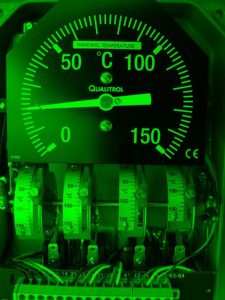In the part 1 article of this topic, we briefly mentioned some mechanical and technical features of the thermal cameras. Basically, what was mentioned was the way these cameras are able to read objects, thermally.
So in this article we will dive a little bit deeper into this and figure out a few more cool things about it. So we are going to focus on the qualities of the camera that are important for quantitative measures.

When we say quantitative measures, up to now we have been looking for things like temperature differentials. If you have a thermal camera, think of a home inspector who may see if there is a problem with the insulation of the house. He scans for gaps of cold air coming through the window, or in the case that the house is not sealed properly. Think of someone like a termite terminator. Someone is coming in your home and they know there are termites, but they need to find the nest. If you have a camera with good sensitivity, you can then scan the walls and look for a heat spot behind the wall which could be the sign of a termite nest. There you are not actually interested in the temperature measurement in terms of quantity but in terms of quality. It’s a qualitative measure which will give you more of a change, that will offer you a sign that you have found what you are looking for. If you are going to be using a camera to inspect a motor and whether it is running warm or hot, there is going to be a certain temperature where the barring is going to start failing. You know what your target is and you want to figure out what the temperature is.
So these cameras can basically provide information on both:
- The temperature degree
- The movement and change of temperature
Thermal imaging as mentioned elsewhere really can be applied in so many different situations where engineering can’t really help much. Companies will use this technology widely, in order to improve the quality of their products. Mainly, manufacturing companies that offer home materials and materials for constructions that are in need to keeping in as much heat as possible. Also, thermal imaging is used by so many contractors in their buildings and structures. The amount of insulation you will put in place, will really depend on how much cold air is getting in the inside of a home, or in the summer: how much hot air is getting in.
By using infrared thermal imaging, what you really can achieve in the insulation example, is understand how many layers of insulation you will install. And it’s an amazing tool because either way it is going to save you lots and lots of money: if you install too much insulation, obviously you are going to be spending more money than you need to. But if you are installing thinner layers of insulation in a residence, then the homeowner will need to spend a lot more money on heating or air conditioning. So thermal imaging – especially considering the dramatic decrease in its costs of buying and operating the equipment – can really be a money saver for both the contractor and the home owner.
I don’t know if I would recommend general consumers – home owners to buy their own infrared thermal camera. I mean, unless you are a DIY type of person and like working on construction around your house, you probably won’t need it as much. But even so, you being the home owner, you can demand your contractor to use this camera. Many times, this is a good way to tell a good construction company from a bad one. I mean if in 2017 people aren’t even aware of the thermal imaging technology available right at their finger tips, then you probably shouldn’t trust your money with them. Residents like being well informed about their options. So I fully recommend, that you discuss the use of thermal imaging technology, with the construction professional to work on a project in your home. If you see he is hesitating and doesn’t like the idea that much, consult with others in the market. Fortunately, there is such a great range of construction companies. Go do your shopping and shop for quality, not just quantity. Other professionals you could request use this technology, are the termite inspectors. As mentioned above, you can easily find that nest by identifying the heat movements behind the wall. It’s a simple process that will save you from a lot of headaches.
So hopefully this article also saved you a bunch of headaches, trying to wrap your head around the concept of thermal imaging and its wonderful applications in our daily lives. As always, stay tuned for a lot more interesting information on infrared thermal imaging.